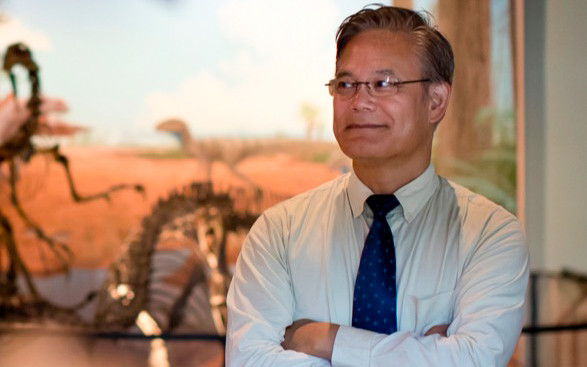
Hearing sounds in only one ear. Blurred central vision but crisp peripheral vision. Difficulty blocking out background noise.
Many people with autism-spectrum disorder experience these and other struggles associated with hypersensitivity or decreased sensitivity to sensory information like sights and sounds that can make it difficult to enjoy being in public.
This is why occupational therapy professor Roger Ideishi started a program that makes art organizations and spaces, like theaters and museums, more inclusive for people with disabilities. Ideishi directs the faculty research program, which doesn’t change the content of exhibits or performances, but makes sound and light settings more gradual and provides staff trainings on accommodating people who have disabilities, like letting individuals know exactly what to expect in a public space.
The program focuses on people with autism-spectrum disorder, but also helps provide accommodations for people with hearing disabilities and people who use wheelchairs.
Joanna Reed, a graduate occupational therapy student who participates in the project, said she grew up going to dance and symphony performances with her family.
“Families with kiddos with autism or families where someone is a wheelchair user, they should get that same kind of enriching experience that we all have,” she added.
After events, graduate students in the project give attendees materials encouraging them to leave feedback on accommodations. They also create pre-visit materials, often in collaboration with the art institutions they are helping, that range from phone apps to brochures and paper guides that are distributed to families and children before shows.
The students also send follow-up surveys asking for tips on how to improve future sensory-friendly performances and understand if families thought the performances were successful and why.
“To prepare themselves for the experience, they can learn about where quiet spaces in the [museum] might be, who the different people are…that will be there and will be talking to them, like the person that takes their ticket,” Reed said. “We create tailored guides to help them, so [their] mom or dad can prep them for the experience.”
Ideishi has been working on the program across the country for more than a decade.
He began his clinical work in preschool and primary school classrooms and found the strategies he used, like scripting and practicing behavioral skills, were very similar to art-based theater strategies. Scripting uses pre-written scripts to guide the students in behavioral and verbal responses to a situation, which is similar to following a script during a theater performance.
In his research, Ideishi has worked with Philadelphia institutions like the Walnut Street Theater on Walnut Street near 8th, to make them more accessible. His project has also worked in other areas like Pittsburgh and Washington, D.C.
Ideishi said because organizations all over the country were implementing sensory-friendly systems, Philadelphia establishments like The Franklin Institute and the Philadelphia Zoo soon followed suit about six years ago.
“That’s when things started to happen in Philadelphia,” he added. “Now…Philadelphia is one of the leaders in this area.”
In September, Ideishi’s program worked with organizations participating in the Fringe Festival, an annual arts festival.
During the festival, FringeArts held two theater performances that offered accommodations for people with hearing disabilities.
On Sept. 7 and 8, Reed participated in one of the plays, “The Accountant,” by providing captions during the performance, which also offered sign language interpretation. These accommodations helped audience members who were deaf, or had other hearing disabilities, enjoy the show.
Ideishi said he has found transforming art spaces to become more sensory friendly is relatively easy and inexpensive.
Christina Neroni, a graduate occupational therapy student who works with the program, said organizations often reach out to Ideishi to find out how they can make their spaces and programs more inclusive.
Neroni said program participants will turn up an organization’s lights, lower the sound and keep theater doors open so people can feel free to go out into the lobby and take a break from crowds and performances.
As people with disabilities sometimes find it difficult to sit still, the theaters will often allow audience members to walk around in the audience during a show to help them focus.
The project’s research plays a crucial role in ensuring public spaces are inclusive and considerate of different needs. It mostly indicates that parents feel isolated from their communities, and are often on “high alert” while in public to make sure their child was not disturbing others.
Ideishi said that now, with more organizations looking to become more sensory friendly and the help of his team, families can go out in the community, relax and enjoy the arts together.
“Some of the youth and young adults who have disabilities, some of the things that they’ve said is, ‘I get to be who I am,’” Ideishi said. “Why shouldn’t we as a society want that for everyone?”



Be the first to comment